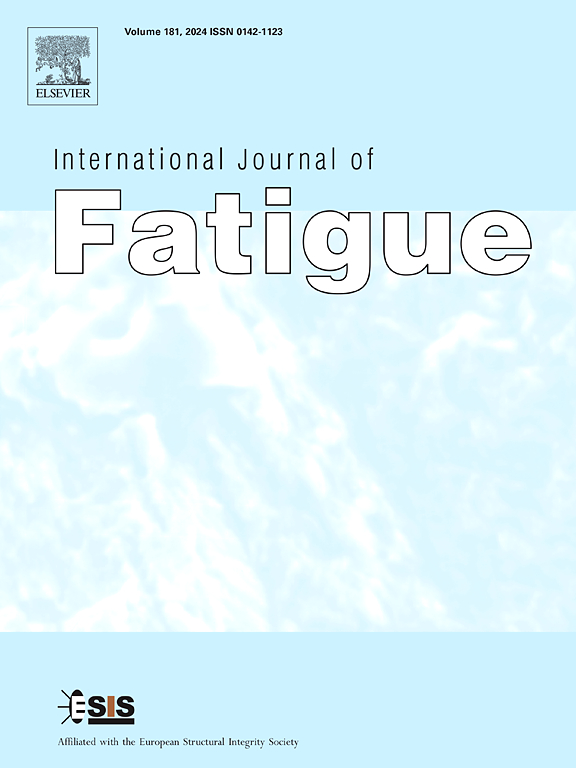采用细颗粒强化预处理提高含硫层低合金钢旋转弯曲疲劳性能
IF 5.7
2区 材料科学
Q1 ENGINEERING, MECHANICAL
引用次数: 0
摘要
研究了细颗粒强化(FPP)(即直径小于200 μm的细颗粒强化)和硫化复合表面改性对低合金钢(AISI4120)疲劳性能的影响。以硫化铁(fe)颗粒或钢颗粒为前处理,采用电化学抛光和FPP法制备了3种类型的硫化样品。通过旋转弯曲疲劳试验,评价了经FPP预处理的硫化试样在环境空气中的疲劳性能。使用钢颗粒的FPP提高了经硫化处理的试样的疲劳极限。在恒应力幅下,采用cosα法测定疲劳试验前后的残余应力,探讨残余应力松弛作用下疲劳极限提高的机理。此外,利用电子背散射衍射和x射线衍射分析了表面改性试样的微观结构。FPP形成细晶粒;而FPP采用FeS颗粒形成的细粒层在随后的硫化过程中消失。相反,在随后的硫化过程中,使用钢颗粒的FPP形成的细晶粒仍然存在,这使得硫化钢的疲劳性能得到改善。本文章由计算机程序翻译,如有差异,请以英文原文为准。
Improvement of fatigue performance of low-alloy steels with a sulfurized layer using fine particle peening as pre-treatment under rotating bending
The influence of a hybrid surface modification combining fine particle peening (FPP), which is defined as peening using particles less than 200 μm in diameter, and sulfurizing on the fatigue properties of low-alloy steels (AISI4120) were investigated. Three types of sulfurized samples were prepared by electrochemical polishing and FPP with iron(II) sulfide (FeS) particles or steel particles as a pre-treatment. Fatigue tests were conducted under rotating bending to evaluate the fatigue performance of sulfurized specimens pre-treated with FPP in ambient air. FPP using steel particles increased the fatigue limit of specimens treated with sulfurizing. Moreover, residual stress was measured using the cosα method before and after fatigue tests under constant stress amplitude to examine the mechanism by which the fatigue limit increases considering residual stress relaxation. In addition, the microstructure of surface-modified specimens was analysed using electron backscattered diffraction and X-ray diffraction. Fine crystal grains were formed by FPP; however, the fine-grained layer formed by FPP using FeS particles disappeared during the subsequent sulfurizing. By contrast, fine grains formed by FPP using steel particles remained during the following sulfurizing, which resulted in an improvement of the fatigue performance of sulfurized steels.
求助全文
通过发布文献求助,成功后即可免费获取论文全文。
去求助
来源期刊

International Journal of Fatigue
工程技术-材料科学:综合
CiteScore
10.70
自引率
21.70%
发文量
619
审稿时长
58 days
期刊介绍:
Typical subjects discussed in International Journal of Fatigue address:
Novel fatigue testing and characterization methods (new kinds of fatigue tests, critical evaluation of existing methods, in situ measurement of fatigue degradation, non-contact field measurements)
Multiaxial fatigue and complex loading effects of materials and structures, exploring state-of-the-art concepts in degradation under cyclic loading
Fatigue in the very high cycle regime, including failure mode transitions from surface to subsurface, effects of surface treatment, processing, and loading conditions
Modeling (including degradation processes and related driving forces, multiscale/multi-resolution methods, computational hierarchical and concurrent methods for coupled component and material responses, novel methods for notch root analysis, fracture mechanics, damage mechanics, crack growth kinetics, life prediction and durability, and prediction of stochastic fatigue behavior reflecting microstructure and service conditions)
Models for early stages of fatigue crack formation and growth that explicitly consider microstructure and relevant materials science aspects
Understanding the influence or manufacturing and processing route on fatigue degradation, and embedding this understanding in more predictive schemes for mitigation and design against fatigue
Prognosis and damage state awareness (including sensors, monitoring, methodology, interactive control, accelerated methods, data interpretation)
Applications of technologies associated with fatigue and their implications for structural integrity and reliability. This includes issues related to design, operation and maintenance, i.e., life cycle engineering
Smart materials and structures that can sense and mitigate fatigue degradation
Fatigue of devices and structures at small scales, including effects of process route and surfaces/interfaces.
 求助内容:
求助内容: 应助结果提醒方式:
应助结果提醒方式:


